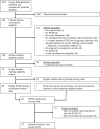Overestimation of Postpartum Depression Prevalence Based on a 5-item Version of the EPDS: Systematic Review and Individual Participant Data Meta-analysis
- PMID: 33104415
- PMCID: PMC7658422
- DOI: 10.1177/0706743720934959
Overestimation of Postpartum Depression Prevalence Based on a 5-item Version of the EPDS: Systematic Review and Individual Participant Data Meta-analysis
Abstract
Objective: The Maternal Mental Health in Canada, 2018/2019, survey reported that 18% of 7,085 mothers who recently gave birth reported "feelings consistent with postpartum depression" based on scores ≥7 on a 5-item version of the Edinburgh Postpartum Depression Scale (EPDS-5). The EPDS-5 was designed as a screening questionnaire, not to classify disorders or estimate prevalence; the extent to which EPDS-5 results reflect depression prevalence is unknown. We investigated EPDS-5 ≥7 performance relative to major depression prevalence based on a validated diagnostic interview, the Structured Clinical Interview for DSM (SCID).
Methods: We searched Medline, Medline In-Process & Other Non-Indexed Citations, PsycINFO, and the Web of Science Core Collection through June 2016 for studies with data sets with item response data to calculate EPDS-5 scores and that used the SCID to ascertain depression status. We conducted an individual participant data meta-analysis to estimate pooled percentage of EPDS-5 ≥7, pooled SCID major depression prevalence, and the pooled difference in prevalence.
Results: A total of 3,958 participants from 19 primary studies were included. Pooled prevalence of SCID major depression was 9.2% (95% confidence interval [CI] 6.0% to 13.7%), pooled percentage of participants with EPDS-5 ≥7 was 16.2% (95% CI 10.7% to 23.8%), and pooled difference was 8.0% (95% CI 2.9% to 13.2%). In the 19 included studies, mean and median ratios of EPDS-5 to SCID prevalence were 2.1 and 1.4 times.
Conclusions: Prevalence estimated based on EPDS-5 ≥7 appears to be substantially higher than the prevalence of major depression. Validated diagnostic interviews should be used to establish prevalence.
Objectif:: L’enquête de 2018-2019 sur la santé mentale maternelle au Canada a révélé que 18 % des 7 085 mères qui ont donné naissance récemment ont déclaré des « sentiments compatibles avec la dépression du postpartum » d’après des scores ≥7 à la version en 5 items de l’échelle de dépression postpartum d’Édimbourg (EDPE-5). L’échelle EDPE-5 a été conçue comme un questionnaire de dépistage, et non pas pour classer les troubles ou estimer la prévalence; la mesure dans laquelle les résultats de l’EDPE reflètent la prévalence de la dépression est inconnue. Nous avons investigué le rendement de l’EDPE-5 ≥7 relativement à la prévalence de la dépression majeure d’après une entrevue diagnostique validée, l’entrevue clinique structurée pour le DSM (ECSD).
Méthodes:: Nous avons cherché dans Medline, Medline In-Process & Other Non-Indexed Citations, PsycINFO, et Web of Science Core Collection jusqu’en juin 2016 des études qui comportaient des ensembles de données et des données de réponse aux items afin de calculer les scores à l’EDPE-5, et qui utilisaient l’ECSD pour estimer l’état de la dépression. Nous avons mené une méta-analyse des données individuelles des participants pour estimer le pourcentage regroupé de l’EDPE-5 ≥7, l’ECSD regroupée pour la prévalence de la dépression majeure, et la différence de prévalence regroupée.
Résultats:: Tirés de 19 études principales, 3 958 participants ont été inclus. La prévalence regroupée de la dépression majeure selon l’ECSD était de 9,2 % (intervalle de confiance [IC] à 95 % 6,0 % à 13,7 %), le pourcentage regroupé des participants ayant une EDPE-5 ≥7 était de 16,2 % (IC à 95 % 10,7 % à 23,8 %), et la différence regroupée était de 8,0 % (IC à 95 % 2,9 % à 13,2 %). Dans les 19 études incluses, le rapport moyen et médian de l’EDPE-5 à la prévalence ECSD était de 2,1 et de 1,4 fois.
Conclusions:: La prévalence estimée selon l’EDPE-5 ≥7 semble substantiellement plus élevée que la prévalence de la dépression majeure. Des entrevues diagnostiques validées devraient être employées pour établir la prévalence.
Keywords: epidemiology; evidence-based medicine; obstetrics and gynecology; psychiatry; statistics and research methods.
Conflict of interest statement
Figures
References
-
- Stewart DE. Perinatal depression. Gen Hosp Psychiatry. 2006;28:1–2. - PubMed
-
- Howard LM, Molyneaux E, Dennis CL, Rochat T, Stein A, Milgrom J. Non-psychotic mental disorders in the perinatal period. Lancet. 2014;384(9956):1775–1788. - PubMed
-
- Stewart DE, Vigod S. Postpartum depression. N Eng J Med. 2016;375(1):2177–2186. - PubMed
-
- O’Hara MW, Swain AM. Rates and risk of postpartum depression—a meta-analysis. Int Rev Psychiatry. 1996;8(1):37–54.
-
- Gavin NI, Gaynes BN, Lohr KN, Meltzer-Brody S, Gartlehner G, Swinson T. Perinatal depression: a systematic review of prevalence and incidence. Obstet Gynecol. 2005;106(5):1071–1083. - PubMed
Publication types
MeSH terms
Grants and funding
LinkOut - more resources
Full Text Sources
Medical


